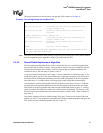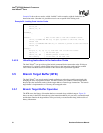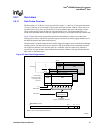
Hardware Reference Manual 91
Intel
®
IXP2800 Network Processor
Intel XScale
®
Core
3.4.1.5 Parity Protection
The instruction cache is protected by parity to ensure data integrity. Each instruction cache word
has 1 parity bit. (The instruction cache tag is not parity protected.) When a parity error is detected
on an instruction cache access, a prefetch abort exception occurs if the Intel XScale
®
core attempts
to execute the instruction. Before servicing the exception, hardware place a notification of the error
in the Fault Status register (Coprocessor 15, register 5).
A software exception handler can recover from an instruction cache parity error. This can be
accomplished by invalidating the instruction cache and the branch target buffer and then returning
to the instruction that caused the prefetch abort exception. A simplified code example is shown in
Example 17. A more complex handler might choose to invalidate the specific line that caused the
exception and then invalidate the BTB.
If a parity error occurs on an instruction that is locked in the cache, the software exception handler
needs to unlock the instruction cache, invalidate the cache and then re-lock the code in before it
returns to the faulting instruction.
3.4.1.6 Instruction Cache Coherency
The instruction cache does not detect modification to program memory by loads, stores or actions
of other bus masters. Several situations may require program memory modification, such as
uploading code from disk.
The application program is responsible for synchronizing code modification and invalidating the
cache. In general, software must ensure that modified code space is not accessed until modification
and invalidating are completed.
To achieve cache coherence, instruction cache contents can be invalidated after code modification
in external memory is complete.
If the instruction cache is not enabled, or code is being written to a non-cacheable region, software
must still invalidate the instruction cache before using the newly-written code. This precaution
ensures that state associated with the new code is not buffered elsewhere in the processor, such as
the fetch buffers or the BTB.
Naturally, when writing code as data, care must be taken to force it completely out of the processor
into external memory before attempting to execute it. If writing into a non-cacheable region,
flushing the write buffers is sufficient precaution. If writing to a cacheable region, then the data
cache should be submitted to a Clean/Invalidate operation to ensure coherency.
Example 17. Recovering from an Instruction Cache Parity Error
; Prefetch abort handler
MCR P15,0,R0,C7,C5,0 ; Invalidate the instruction cache and branch target
; buffer
CPWAIT ; wait for effect
;
SUBS PC,R14,#4 ; Returns to the instruction that generated the
; parity error
; The Instruction Cache is guaranteed to be invalidated at this point


















